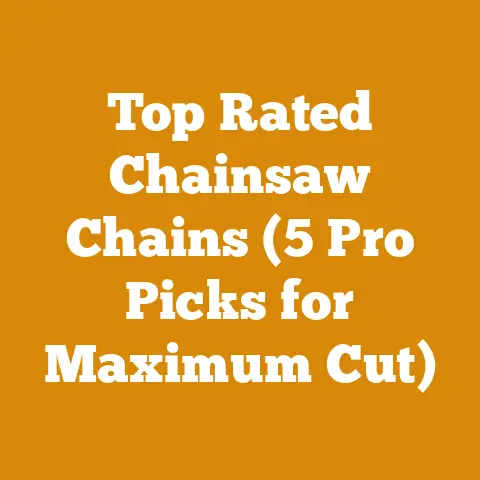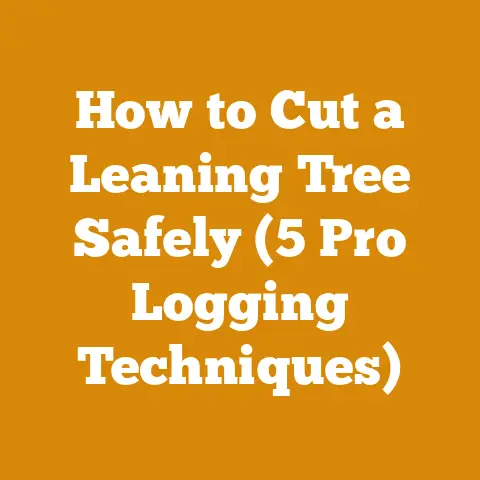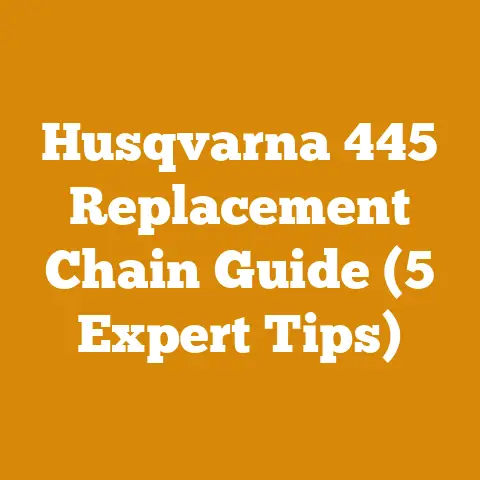Bagworms on Leyland Cypress (5 Proven Woodcare Hacks)
As the leaves begin to turn and the air takes on a crisp edge, I know it’s time to start thinking about firewood. But it’s also the time of year when I often get calls from folks concerned about their Leyland Cypress trees. They see these strange, dangling bags and immediately worry. More often than not, they’re dealing with bagworms. While bagworms might seem like a purely ornamental issue, their presence, if left unchecked, can significantly impact the health and even the structural integrity of trees that might eventually become valuable timber or firewood. Understanding how to deal with them is crucial for anyone involved in wood processing, logging, or even just firewood preparation. A healthy tree yields better wood, plain and simple.
Bagworms on Leyland Cypress: 5 Proven Woodcare Hacks
Bagworms are fascinating (and frustrating!) creatures. They’re not worms at all, but moth larvae that create distinctive silken bags covered in bits of foliage. These bags serve as both shelter and camouflage. Left unchecked, a heavy infestation can defoliate a Leyland Cypress, weakening it and making it more susceptible to diseases and other pests. This is where my experience in wood processing comes into play. A stressed tree isn’t just an eyesore; it’s a tree that won’t produce quality wood.
Here are five proven woodcare hacks to tackle bagworms on your Leyland Cypress, drawing on my knowledge of tree health and wood quality:
Understanding the Enemy: Bagworm Basics
Before I dive into the solutions, let’s get a clear understanding of what we’re dealing with.
What are Bagworms?
Bagworms are the larval stage of certain moths in the family Psychidae. The most common species affecting Leyland Cypress is the evergreen bagworm, Thyridopteryx ephemeraeformis. The larvae construct cone-shaped bags from silk and pieces of foliage, which they carry with them as they feed.
The Bagworm Life Cycle
Understanding the life cycle is key to effective control:
- Overwintering: Bagworm eggs overwinter inside the female’s bag.
- Hatching: In late spring to early summer (typically May to June), the eggs hatch, and the tiny larvae emerge.
- Feeding and Bag Construction: The larvae begin feeding on the foliage and constructing their bags, adding to them as they grow.
- Pupation: In late summer, the larvae pupate inside their bags.
- Adult Stage: Male moths emerge from the bags and fly to find females. The wingless female remains in her bag, mates, and lays eggs inside.
- Death: After laying eggs, the female dies inside her bag.
Why Bagworms Matter to Wood Processing
A healthy tree is a productive tree. Bagworm infestations stress Leyland Cypress, making them:
- Weaker: Defoliation weakens the tree, reducing its ability to withstand wind and snow loads. This is critical if you’re planning to harvest the tree for timber later.
- More Susceptible to Disease: Stressed trees are more vulnerable to fungal diseases and other pests.
- Less Valuable as Timber: A diseased or weakened tree will produce lower-quality wood, potentially with knots, rot, or uneven grain. This directly impacts its value for woodworking or firewood.
- Firewood Concerns: While bagworm-infested wood can still be burned, the weakened state of the tree can lead to faster decay, making it less dense and efficient as firewood.
Hack #1: The Manual Removal Method: Get Hands-On
This is the most straightforward and often the most effective method, especially for smaller trees or light infestations.
Step-by-Step Guide to Manual Removal
- Timing is Crucial: The best time to remove bagworms manually is during the late fall, winter, or early spring, before the eggs hatch. You’re essentially removing the future generation of bagworms.
- Gear Up: Wear gloves to protect your hands. I also recommend eye protection, as debris can fall while you’re working.
- Inspect Thoroughly: Carefully examine the Leyland Cypress for bags. Pay close attention to the interior branches, as bagworms often hide there.
- Snip and Collect: Use pruning shears or scissors to cut the bags from the branches. Be careful not to damage the surrounding foliage.
- Dispose Properly: Place the collected bags in a sealed plastic bag and dispose of them in the trash. Do not compost them, as the eggs can survive and hatch.
- Follow-Up: Re-inspect the tree periodically to ensure you haven’t missed any bags.
My Personal Experience
I remember one winter helping a neighbor with a severe bagworm infestation on his Leyland Cypress hedge. We spent an entire afternoon meticulously removing bags. It was tedious, but the following summer, the hedge was noticeably healthier and bagworm-free. This experience taught me the value of persistence and thoroughness in manual removal.
Tools and Measurements
- Pruning Shears: Use sharp, bypass pruning shears for clean cuts. I prefer Felco F-8 shears for their durability and ergonomic design.
- Gloves: Leather work gloves or nitrile gloves.
- Trash Bags: Heavy-duty plastic trash bags.
Strategic Advantages
- Environmentally Friendly: No chemicals are involved.
- Targeted: You’re removing the pests directly, minimizing harm to beneficial insects.
- Effective: For small infestations, manual removal can completely eliminate the problem.
Cost and Skill Level
- Cost: Minimal – just the cost of gloves and trash bags.
- Skill Level: Beginner.
Hack #2: Bacillus Thuringiensis (Bt) Sprays: The Biological Weapon
Bacillus thuringiensis (Bt) is a naturally occurring bacterium that produces proteins toxic to certain insects, including bagworms. It’s a safe and effective biological control method when used correctly.
How Bt Works
Bt works by producing a protein that paralyzes the digestive system of susceptible insects. When bagworms ingest Bt-treated foliage, they stop feeding and eventually die.
Step-by-Step Guide to Bt Application
- Choose the Right Bt Product: Look for a Bt product specifically formulated for caterpillar control, such as Bacillus thuringiensis var. kurstaki (Btk).
- Timing is Critical: Bt is most effective on young bagworm larvae. Apply it in late spring to early summer, shortly after the eggs hatch. You’ll need to monitor your trees closely to catch the larvae at the right stage.
- Mix the Solution: Follow the instructions on the product label carefully to mix the correct concentration of Bt with water. Use a clean sprayer.
- Spray Thoroughly: Apply the Bt solution to all parts of the Leyland Cypress, paying particular attention to the foliage where bagworms are feeding. Make sure to coat the needles evenly.
- Reapply as Needed: Bt breaks down quickly in sunlight and rain. Reapply the spray every 7-10 days, or as directed on the product label, until the bagworm infestation is under control.
- Monitor Results: Check the trees regularly to see if the Bt treatment is working. You should see a reduction in bagworm feeding activity.
My Personal Experience
I’ve used Bt sprays successfully on several occasions to control bagworms on ornamental trees. One thing I’ve learned is that timing is everything. If you wait too long, the bagworms will be too large and the Bt will be less effective. I now keep a close eye on my trees in the spring and apply Bt at the first sign of bagworm activity.
Tools and Measurements
- Sprayer: A pump sprayer or backpack sprayer. I prefer a backpack sprayer for larger trees.
- Bt Product: Bacillus thuringiensis var. kurstaki (Btk). Examples include Safer Brand Caterpillar Killer or Thuricide.
- Measuring Cups/Spoons: For accurate mixing.
- Personal Protective Equipment (PPE): Gloves, eye protection, and a respirator (especially when using concentrated products).
Strategic Advantages
- Environmentally Friendly: Bt is a natural product that is safe for humans, pets, and beneficial insects when used correctly.
- Effective: Bt is highly effective against young bagworm larvae.
- Relatively Inexpensive: Bt products are generally affordable.
Cost and Skill Level
- Cost: $15-$30 for a Bt concentrate.
- Skill Level: Beginner to Intermediate (requires careful mixing and application).
Hack #3: Horticultural Oil: Suffocation Station
Horticultural oil, also known as dormant oil, is a refined petroleum or vegetable oil that suffocates insects by blocking their breathing pores. It’s a safe and effective option, especially for overwintering eggs.
How Horticultural Oil Works
Horticultural oil works by coating the bagworms or their eggs with a thin layer of oil, which blocks their spiracles (breathing pores) and causes them to suffocate.
Step-by-Step Guide to Horticultural Oil Application
- Choose the Right Oil: Use a horticultural oil specifically labeled for use on evergreens. Avoid using regular motor oil or other unrefined oils, as they can damage the trees.
- Timing is Important: Apply horticultural oil in the late fall or early spring, before the eggs hatch. This is when the bagworms are most vulnerable.
- Mix the Solution: Follow the instructions on the product label carefully to mix the correct concentration of horticultural oil with water.
- Spray Thoroughly: Apply the horticultural oil solution to all parts of the Leyland Cypress, paying particular attention to the bags. Make sure to coat the bags evenly.
- Avoid Over-Application: Do not apply horticultural oil on hot, sunny days or when temperatures are below freezing, as this can damage the trees.
- Monitor Results: Check the trees regularly to see if the horticultural oil treatment is working.
My Personal Experience
I’ve found horticultural oil to be a great preventative measure. I apply it to my Leyland Cypress trees in the late fall after I’ve done a manual removal. It’s like a double-whammy that really knocks back the bagworm population.
Tools and Measurements
- Sprayer: A pump sprayer or backpack sprayer.
- Horticultural Oil: Look for a product specifically labeled for use on evergreens.
- Measuring Cups/Spoons: For accurate mixing.
- PPE: Gloves, eye protection.
Strategic Advantages
- Relatively Safe: Horticultural oil is relatively safe for humans, pets, and beneficial insects when used correctly.
- Effective: Horticultural oil is effective against bagworm eggs and young larvae.
- Can be Used Year-Round: Dormant oil can be applied during the dormant season, while summer oil can be used during the growing season.
Cost and Skill Level
- Cost: $20-$40 for a horticultural oil concentrate.
- Skill Level: Beginner to Intermediate (requires careful mixing and application).
Hack #4: Insecticides: The Chemical Option (Use with Caution)
While I generally prefer non-chemical methods, insecticides can be necessary for severe bagworm infestations. However, it’s crucial to use them responsibly and with caution.
Choosing the Right Insecticide
- Read the Label: Always read and follow the instructions on the product label carefully.
- Targeted Insecticides: Look for insecticides specifically labeled for use on bagworms.
- Consider the Impact on Beneficial Insects: Choose insecticides that are less harmful to beneficial insects, such as bees and ladybugs.
Step-by-Step Guide to Insecticide Application
- Timing is Critical: Apply insecticides when the bagworms are young and actively feeding. This is typically in late spring to early summer.
- Mix the Solution: Follow the instructions on the product label carefully to mix the correct concentration of insecticide with water.
- Spray Thoroughly: Apply the insecticide solution to all parts of the Leyland Cypress, paying particular attention to the foliage where bagworms are feeding.
- Wear Protective Gear: Always wear gloves, eye protection, and a respirator when applying insecticides.
- Avoid Drift: Do not apply insecticides on windy days, as the spray can drift to other plants or areas.
- Reapply as Needed: Insecticides may need to be reapplied every 7-10 days, or as directed on the product label, until the bagworm infestation is under control.
My Personal Experience
I’ve only used insecticides as a last resort for severe bagworm infestations. I always try to use the least toxic option possible and apply it carefully to minimize the impact on beneficial insects. I also make sure to monitor the trees closely after application to assess the effectiveness of the treatment.
Tools and Measurements
- Sprayer: A pump sprayer or backpack sprayer.
- Insecticide: Examples include pyrethroid-based insecticides (e.g., permethrin, bifenthrin).
- Measuring Cups/Spoons: For accurate mixing.
- PPE: Gloves, eye protection, respirator, long sleeves, and pants.
Strategic Disadvantages
- Environmental Impact: Insecticides can be harmful to beneficial insects, wildlife, and the environment.
- Resistance: Bagworms can develop resistance to insecticides over time, making them less effective.
- Toxicity: Insecticides can be toxic to humans and pets.
Cost and Skill Level
- Cost: $15-$50 for an insecticide concentrate.
- Skill Level: Intermediate to Advanced (requires careful mixing, application, and safety precautions).
Hack #5: Promoting Tree Health: The Long-Term Solution
The best defense against bagworms is a healthy tree. Proper care and maintenance can make your Leyland Cypress less susceptible to infestation.
Key Practices for Tree Health
- Watering: Water deeply and regularly, especially during dry periods. Leyland Cypress trees need consistent moisture, particularly when young.
- Fertilizing: Fertilize in the spring with a balanced fertilizer formulated for evergreens. This provides essential nutrients for growth and vigor. I usually use a slow-release fertilizer with a N-P-K ratio of around 12-6-6.
- Mulching: Apply a layer of mulch around the base of the tree to help retain moisture, suppress weeds, and regulate soil temperature. Use organic mulch, such as wood chips or pine straw.
- Pruning: Prune regularly to remove dead, damaged, or diseased branches. This improves air circulation and reduces the risk of fungal infections.
- Soil Testing: Conduct a soil test to determine the pH and nutrient levels. Amend the soil as needed to create optimal growing conditions.
My Personal Experience
I’ve seen firsthand how healthy trees are more resilient to pests and diseases. I make sure to provide my Leyland Cypress trees with proper care and maintenance, and they rarely have problems with bagworms.
Tools and Measurements
- Watering Hose or Sprinkler: For regular watering.
- Fertilizer Spreader: For even fertilizer application.
- Mulch: Wood chips, pine straw, or other organic mulch.
- Pruning Tools: Pruning shears, loppers, and a pruning saw.
- Soil Testing Kit: To determine soil pH and nutrient levels.
Strategic Advantages
- Long-Term Solution: Promoting tree health is a long-term strategy that makes trees more resistant to pests and diseases.
- Environmentally Friendly: This approach focuses on natural methods and reduces the need for chemical interventions.
- Improves Overall Tree Quality: Healthy trees are more attractive and valuable.
Cost and Skill Level
- Cost: Varies depending on the materials and tools used.
- Skill Level: Beginner to Intermediate (requires knowledge of tree care practices).
Case Study: The Firewood Farmer’s Dilemma
Let me share a scenario I encountered a few years back. A local firewood farmer, let’s call him John, had a stand of Leyland Cypress he planned to harvest for firewood. He noticed a significant bagworm infestation and was worried about the impact on the wood quality.
Here’s how we approached the situation:
- Assessment: We assessed the severity of the infestation. It was moderate, with noticeable defoliation but no signs of widespread tree death.
- Prioritization: John was on a tight timeline to harvest the wood before winter. We opted for a combination of manual removal (for the larger, more visible bags) and a targeted Bt spray application.
- Harvesting Strategy: We prioritized harvesting the most heavily infested trees first. This prevented the bagworms from spreading further and allowed the healthier trees to recover.
- Wood Processing: During processing, we carefully inspected the logs for signs of decay or damage caused by the bagworm infestation. Any severely affected wood was separated for burning in an outdoor furnace rather than being sold as premium firewood.
- Long-Term Prevention: We discussed long-term strategies for preventing future infestations, including promoting tree health through proper watering, fertilization, and mulching.
The result? John was able to salvage a significant portion of the firewood, minimize the impact of the bagworm infestation, and implement a plan to prevent future problems. This case study highlights the importance of a multi-faceted approach that combines immediate action with long-term prevention.
The Link to Wood Processing and Firewood Preparation
You might be wondering, “Why is all this bagworm talk relevant to someone interested in wood processing or firewood?” The answer is simple: the health of the tree directly impacts the quality of the wood.
- Wood Density: A stressed tree produces less dense wood, which means less heat output when burned as firewood.
- Decay Resistance: Weakened trees are more susceptible to fungal decay, making the wood less durable and less valuable.
- Structural Integrity: Bagworm infestations can weaken branches, making them more prone to breakage during felling and processing.
- Overall Value: A healthy tree yields more valuable wood, whether you’re selling it as timber, firewood, or using it for woodworking projects.
Safety Considerations
No matter which method you choose, safety should always be your top priority.
- Inspect Your Trees: Examine your Leyland Cypress trees carefully for signs of bagworms.
- Choose a Control Method: Select the method that is best suited to your situation, considering the severity of the infestation, your budget, and your environmental concerns.
- Implement Your Plan: Follow the instructions provided in this guide to implement your chosen control method.
- Monitor Your Trees: Check your trees regularly to assess the effectiveness of your treatment and make adjustments as needed.
- Promote Tree Health: Implement long-term strategies to promote the health and vigor of your Leyland Cypress trees.
By taking these steps, you can protect your trees from bagworm infestations and ensure that they remain healthy and productive for years to come. This not only improves the aesthetic appeal of your landscape but also enhances the value of the wood if you plan to use it for processing or firewood preparation. Remember, a healthy tree is a valuable asset, and taking care of it is an investment in the future.






